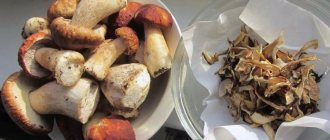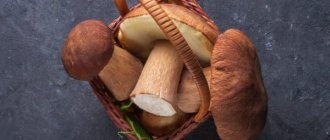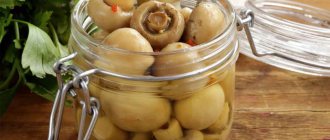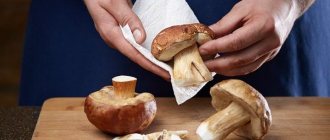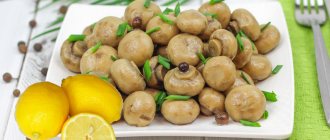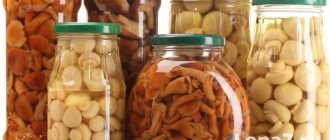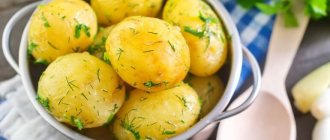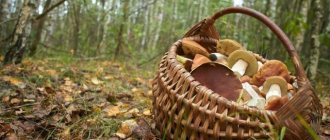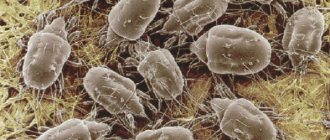The mushroom picking season has already begun in almost all regions of Russia and thousands of mushroom pickers have gone into the forest for a new “wild” harvest. Unfortunately, some of these people can become seriously poisoned due to their own carelessness or inexperience. To prevent this from happening, you need to be able to distinguish edible mushrooms from inedible ones. This can be done based on a number of external signs of the fungus. Of course, each species has its own differences, but there are also common characteristics of poisonous and inedible mushrooms.
Types of mushrooms
Mushrooms are divided into:
- edible;
- inedible;
- conditionally edible.
Edible mushrooms, photo and name, and description, of course, will help you decide when identifying a valuable food product rich in proteins and vitamins, minerals and aromatics. The number of edible mushrooms reaches 500 species, but no more than 100 species are known to a wide circle, and no more than 10-15 are known to most mushroom pickers. Great lovers and connoisseurs of mushrooms will always help a beginner understand their findings, but one should not trust them completely; mistakes are human.
How not to confuse the porcini mushroom.
Therefore, by carefully looking at the photo and remembering exactly what the most common and valuable mushrooms look like, you can easily and independently decide on the edibility of a mushroom.
How to determine when cooking whether the mushrooms are poisonous or not?
Few people know how to identify poisonous mushrooms when cooking.
In addition, few people know that they cannot be 100% classified as plants, since they contain signs of the animal world too. There are about 1.5 million species, subspecies and varieties of mushrooms in nature. This figure is a bit approximate, since scientists and avid mushroom pickers are discovering more and more new specimens. Science does not have an exact number of edible and poisonous mushrooms. It is believed that their percentage is 50/50, that is, they are equally divided.
Poisonous mushrooms can also be identified at the cooking stage.
This product is a common and favorite dish of many. In some national cuisines this product occupies a special, privileged place. Mushrooms can be pickled, salted, dried, served fried or boiled. There are a lot of recipes with this delicacy. Food with them acquires an extraordinary, unforgettable taste, and dishes decorated with this dish are a delight to the eye on any holiday table.
What are poisonous mushrooms
Dangerous poisonous mushrooms are distinguished by the presence of toxins, and known poisonous components are represented by three main groups:
- The first group includes local toxins that can cause various disorders in the digestive system. This category includes species represented by russula, satanic mushroom, undercooked autumn honey mushrooms, variegated and yellow-skinned champignon, false puffball and tiger row. In rare cases, death may occur;
- The second group includes neurotropic toxins that have a pronounced effect on the human nervous system. The first symptoms of poisoning appear after about half an hour and can include hallucinations, loss of consciousness and severe indigestion. The group includes fly agarics, some types of fibers, talkers, rows, Russula vomitus, some hebeloms and entoloms;
- The third group includes toxins that have a pronounced plasmatoxic effect. This group of poisonous mushrooms includes stitches and many lobes, fringed galerina, and orange-red cobweb.
If the mushroom is highly poisonous, then even timely treatment cannot guarantee complete safety.
Interesting read: Red trellis: all about the unusual mushroom.
Why you can’t destroy poisonous mushrooms
The destruction of fungi can cause significant harm to the ecosystem and upset the natural balance. Many spongy and lamellar species that are poisonous to humans are used for medicinal purposes by some large artiodactyls. Also, poisonous varieties find purely practical use. Medicines and healing agents based on them can cure rheumatism, various nervous disorders, lung diseases and oncology, as well as many other pathologies.
Poisonous mushrooms.
Classification
Classification of poisonous mushrooms
If edible mushrooms are classified according to several characteristics (in particular, structure), then poisonous ones have their own system of division into groups. According to how they affect the human body, there are 3 groups of poisonous mushrooms:
- Causes food poisoning (tiger row, satanic mushroom, tin entoloma).
- Affects the central nervous system (panther fly agaric, purple ergot).
- Cause severe poisoning with possible death (pale toadstool, stinking fly agaric).
All three categories are dangerous, but the mushrooms that are included in the third group are the most insidious. The fact is that for the first time after eating them, a person may not feel any changes. Some toxins begin to act in slow motion, thereby delaying the moment of seeking medical help.
There is another classification based on the content of certain toxins:
- Cyclopeptides . The most dangerous poisons. Signs of intoxication appear only after a day or two. Then feeling unwell may stop for a couple of days. A false feeling of recovery arises, after which the person’s condition deteriorates sharply and rapidly. Toxins hit the liver the hardest.
- Cortinarine and orellanine . Poisons affect mainly the stomach and kidneys. Causes pain, gastrointestinal upset and a strong feeling of thirst. Their danger lies in their delayed manifestation - after a week or two.
- Monomethylhydrazine . The toxin, unlike the previous ones, manifests itself very quickly - within a matter of hours after entering the body. However, it affects organs and systems no less.
- Koprin . The toxin has a negative effect only if it is mixed with alcohol shortly after entering the body. As a rule, indigestion and tachycardia occur.
- Muscimol and ibotenic acid . Causes poisoning and general malaise.
- Muscarine. A couple of hours after entering the body it causes fever without increasing body temperature.
- Bufotenin . General malaise only occurs when eating large quantities of mushrooms.
Interesting: White mushroom: description, what it looks like, where it grows, varieties, photos and videos
Also included in a separate group are mushrooms that can cause allergies.
General differences between edible and inedible mushrooms
Sometimes poisoning occurs due to one piece of toadstool or red fly agaric that gets on the table along with edible mushrooms. In order not to confuse edible and inedible mushrooms, it is necessary to accurately understand which specimens are common in the area and what they look like. Only the mushroom that is well known is placed in the basket. Some varieties of edible and inedible crops are similar to each other. Despite the similarities, they also have a number of differences.
- Appearance: the color of edible specimens is often dull, but there are exceptions. For example, the chicken mushroom has a bright yellow cap. The poison in inedible organisms repels insects. Edible specimens most often contain a lot of worms and beetles. Edible varieties also have a skirt. Most poisonous ones do not have it.
- Discoloration at the break (cut): edible and poisonous mushrooms are characterized by this feature. In edible specimens it becomes beige or brown, while in poisonous specimens it acquires a brighter color (red, orange), or the dangerous mushroom turns blue.
- Smell: This is often what determines edibility. Almost all edible mushrooms have a pleasant aroma. Parasitic mushrooms and specimens not suitable for food have a chlorine or medicinal odor, but there are exceptions (fly agaric).
- Cap surface: Many inedible varieties have a sticky cap that feels sticky to the touch. It is also worth avoiding those specimens that do not have a tubular layer under the cap.
- Base of the leg: in poisonous specimens, the base of the leg is almost always immersed (surrounded) by a special sac (volva) - a remnant of the common veil. Edible mushrooms do not have such a formation. Also, in inedible and poisonous specimens, in addition to the volva, the base of the stalk is expanded into a tuber-like well-defined formation.
These are the main differences between edible and inedible mushrooms. Of the poisonous species in Russia, the most common are the pale toadstool (green fly agaric), red fly agaric, thin pig and satanic mushroom. The pale grebe is deadly. If the above signs are absent, but you are not sure that the specimen found does not contain toxic substances, you should not take it.
Fly agaric.
Is there a 100% method for determining the toxicity of a mushroom?
No matter how hard you try, you won’t be able to check with absolute certainty whether a mushroom is edible or not. We can only guess with some certainty.
The most reliable distinguishing feature of edible mushrooms is considered to be the presence of a spongy cap structure, which in harmful specimens is found only in the satanic mushroom. As a rule, false representatives are characterized by a lamellar structure.
Most poisonous mushrooms have a lamellar structure
Myths and folk signs about mushrooms
Many mushroom lovers have to be content with only purchased ones, since not everyone knows how to identify poisonous specimens and distinguish them from edible ones. Of course, banal logic will not allow you to cut off an acid-green specimen into a lilac speck, but many poisonous species look like they are quite edible.
Moreover, there are a lot of misconceptions about how to test mushrooms for toxicity. To refute most of them, experts say that there are no simple ways to determine the toxicity of a mushroom. Many species react differently to the same techniques, and it is very easy to become poisoned by a seemingly edible product.
A young mushroom does not mean it is edible
It is believed that all mushrooms can be eaten while they are young. It is implied that the poison in them appears only over time. This is also an absurd fallacy. For example, the pale grebe is poisonous at any age. It is best to study the mushroom encyclopedia and know the edible species by sight. If you have the slightest doubt about the suitability of a foundling as food, you should throw it away. This is not a case where the risk can be justified.
Phalloidin is one of the most dangerous mushroom poisons. Most of all it is contained in the pale toadstool. In terms of its adverse effects on the human body, phalloidin is equivalent to snake venom. An adult toadstool contains 10 mg of this substance, and when a person consumes 20 mg, 98% of cases result in death.
Will silver help?
There is a misconception: if you put a silver object in water during cooking, it will turn black, indicating that among the products there are poisonous ones. Amino acids that contain sulfur cause blackening of silver. But this substance is present not only in poisonous, but also in edible species. There is even a separate subspecies of poisonous mushrooms that this method will not detect. It follows from this that this method is not at all valuable.
How to determine if a mushroom is edible.
Onion and garlic
While cooking the mushrooms, add onion or garlic to the water. If there are poisonous mushrooms in the container, the heads of the root crops will turn black. It is useless to check the toxicity of mushrooms with onions or garlic during cooking. The color change of onion or garlic to brown during cooking occurs due to the pigment tyrosinase. It is found in both poisonous and edible mushrooms.
Boiling
If you boil fresh mushrooms for several hours, they will lose all their toxicity. Unfortunately, this is not the case - most of the poisons in mushrooms are heat-resistant and are not afraid of heat treatment.
How to pick mushrooms correctly.
sour milk
If you place mushrooms in fresh homemade milk for a while, it will turn sour. Enzymes such as pepsin and organic acids contribute to the sourness of milk. These enzymes are found in edible, inedible and poisonous mushrooms.
Bad smell
Poisonous mushrooms have a strong, unpleasant odor. Odor is an integral part of any mushroom. Only novice mushroom pickers will believe that poisonous mushrooms have a specific vile odor, while edible ones smell acceptable. This argument is not worth a penny. For example, champignon smells exactly the same as the terribly poisonous toadstool. In addition, not all people have a keen sense of smell and are generally able to distinguish the subtleties of mushroom aromas.
Pests
Worms, insects and snails do not eat poisonous mushrooms. If there are traces on the mushroom indicating that some small forest dweller has already feasted on it, then it is edible. This is another tale that circulates among beginners. Larvae, insects, snails and other small animals can spoil the poisonous mushroom with their appetite. Chanterelles and Polish mushrooms remain untouchable.
Alcohol is not a cure for poison
This is one of the most dangerous misconceptions. A high-proof drink will not help, but will greatly aggravate the condition of the person who has eaten poisonous mushrooms. Alcohol-containing substances provoke an accelerated spread of toxic substances throughout the human body, and therefore only accelerate the effect of the poison.
How not to get poisoned by mushrooms.
Pleasant taste
If a mushroom is tasty, it is not poisonous. Many mushroom pickers try raw mushrooms when picking. If it tastes bitter, it is poisonous. It is believed that the minimum amount of poison that enters the body with saliva during tasting will not cause significant harm. Reality: there are clearly poisonous mushrooms without bitterness with a very pleasant taste:
- death cap;
- poisonous entoloma;
- red and panther fly agarics;
- many other types.
Pink records
Pink plates under the cap of the mushroom indicate its edibility. Reality: indeed, young champignons also have pink plates, just like poisonous mushrooms, so this is far from an indicator.
Pink plates of mushroom.
Terrain
Poisonous mushrooms do not grow in open areas, but only in forests. Reality: A completely unfounded misconception. There are numerous cases of poisoning from mushrooms collected in meadows.
Fault color
When the cap is broken, the blue, pink or reddened flesh symbolizes the unfavorability of the find. White, gray, beige and other shades that have not reacted to the oxygen of the pulp indicate edibility. At the break, many edible species turn blue or change color.
There are certain varieties of mushrooms that are partially unsuitable. They need to be boiled for a long time in a special mixture of vinegar and salt, and then when fried they will be completely edible. But this method does not apply to all unfavorable samples.
Information for beginner mushroom pickers
If you have the opportunity to go on your first trips to the forest in the company of experienced mushroom pickers, it is better to take advantage of it. An expert will be able to answer questions that arise during the collection process, dispel doubts about specific specimens and suggest effective methods that will help you understand how to distinguish poisonous mushrooms.
When going to the forest, special attention should be paid to the correct and reasonable selection of clothing. It should not restrict movement, but should reliably protect the body and skin from various insects. Shoes should also be closed, without any additional holes: flip-flops and sandals should be put aside for another occasion. A headdress will come in handy: you can use a cap, hat or scarf.
Proper equipment for a mushroom picker
It is recommended to collect in special baskets, which are made from pine shingles, birch bark or wicker. You should not take buckets and containers made of plastic or plastic and plastic bags with you, especially if you plan to collect redheads, boletus and boletus - in such containers they will wrinkle and break.
You definitely shouldn’t pick mushrooms within a radius of 500-1000 m from roads and busy highways. This is due to the fact that mushrooms are characterized by increased sensitivity to harmful substances, toxins and heavy metals that they accumulate in themselves. Such harmful substances certainly cannot be neutralized using heat or heat treatment.
Poisoning can lead to serious and severe consequences, including death. A separate risk category includes children, the elderly and pregnant women. On average, symptoms of poisoning begin to appear 2 hours after eating the fruit. Symptoms are similar to other types of food poisoning: diarrhea, vomiting, severe abdominal pain and general weakness.
Signs of poisoning from poisonous mushrooms
If the above symptoms occur, you should immediately call an ambulance. While waiting for medical workers to arrive, you need to perform gastric lavage, take activated charcoal, stay in bed and drink plenty of water or strong tea.
It may also be helpful to save any remaining cooked mushrooms that may have caused poisoning. This will make it possible to make a diagnosis faster and more accurately.
Is it possible to get poisoned by edible mushrooms?
Sometimes even eating proven mushrooms can lead to poisoning. This may happen for the following reasons:
- Bacteria. If they enter the nutrient medium of the mushroom body, they begin to multiply intensively. Sources of infection can be soil, transportation containers, even unwashed hands. If the fruits are not properly processed, then when consuming them, you can get bacterial poisoning. However, all these bacteria die after heat treatment. But improper pickling, in which the fruits were kept in the same water for a long time at an elevated ambient temperature, or in which no salt was added, can be dangerous.
- Botulism. This can occur with canned foods due to clostridia spores. If pickled mushrooms are stored indoors without access to air, then they may become contaminated.
- Toxins. Mushrooms, like sponges, absorb all the chemicals around them. Therefore, heavy metals and herbicides that get into fruits growing near agricultural lands or industrial zones also enter the human body, causing severe poisoning.
Homemade canned mushrooms can cause botulism
The digestive system has difficulty digesting heavy mushrooms, so they should be eaten in moderation. And people who have problems with the gastrointestinal tract, kidneys or liver should avoid using this product altogether.
Proper preparation is a guarantee of safety
In order to eat conditionally edible types of mushrooms without fear of poisoning, you should learn how to cook them correctly. This applies to the preparation, in particular, of autumn mushrooms, white and black milk mushrooms and spring morels.
A mandatory step is long-term heat treatment. You will need to cook for 40 minutes, then get rid of the water in which the mushrooms were cooked and rinse them thoroughly. After such a strong treatment, all useful substances, including proteins, are preserved. They only get rid of harmful substances that can spoil the taste of the pulp.
Heat treatment eliminates the bitterness and toxicity of mushrooms
Why you can’t destroy poisonous mushrooms
But it is impossible to destroy and exterminate poisonous mushrooms, otherwise this can cause serious harm to the ecosystem and seriously upset the balance of nature. Many spongy and lamellar species that are dangerous for consumption can be used in the treatment of artiodactyl wild animals. Also, these specimens can be used for medicinal purposes by people. For example, such mushrooms help in the treatment of rheumatism, various nervous and mental disorders, lung diseases, oncology and other pathologies.
Alcohol is not a cure for poison
An alcoholic drink will not only not help, but will also worsen the person’s condition. The fact is that alcohol provokes an accelerated movement of toxic substances in the body, which is why the poison begins to act faster.
It is not recommended to combine mushrooms with alcohol, as it enhances the negative effects of mushroom components on the body.
Poisonous mushrooms in Russian forests
The mortality rate from poisoning with poisonous mushrooms reaches 90% in some cases! Poisonous mushrooms are especially dangerous for children. The main distinguishing feature of poisonous mushrooms is the presence of deadly substances in them, and not external similarity or the absence of any “normal” mushroom characteristic. Therefore, when going on a mushroom hunt, it is important to become thoroughly familiar with the representatives of poisonous mushrooms.
Poisonous mushrooms of Russia.
Death cap
Pale toadstool is perhaps the most poisonous mushroom! It is better to avoid poisoning with toadstool! The appearance of this mushroom is practically not much different from other mushrooms growing in forests, so it can easily be confused with an edible mushroom. The color of the cap of this toadstool is yellowish-brown, pale greenish or greenish-olive. Usually the center of the cap is darker in color than its edges.
The structure of this type of mushroom is quite fleshy, with cylindrical stripes of pale green color. On top of the leg there is a ring of striped pale or white color. Pale grebe (photo) forms mycorrhiza on deciduous trees, growing in mixed and deciduous forests. It begins to bear fruit at the end of summer to the end of September. Toadstool (pictures) is highly toxic.
Death cap.
False honey agaric
The mushroom has a convex cap up to 5 cm in diameter. The color of the cap is predominantly yellowish with a red or orange tint and a darker color in the center. The mushroom has a thin, smooth, hollow, fibrous stem. The flesh of the mushroom is light yellow, has a bitter taste and an unpleasant odor. The false honey fungus lives from June to October. Most often it can be found in fairly large groups on rotting wood.
The mushroom is poisonous and causes digestive upset. After 1-6 hours, signs of poisoning immediately appear: vomiting, loss of consciousness, nausea, excessive sweating. The false honey fungus is similar in appearance to the autumn, winter, summer and gray-plate honey fungus.
False chanterelle (orange talker)
This poisonous mushroom has a brightly colored cap from orange-red to copper-red. The shape of the false chanterelle's cap resembles a funnel with a smooth edge. The plates of the mushroom are bright red, sinuous. The stalk is approximately 10 cm long and 10 mm wide, often narrowed towards the base. False chanterelles mainly grow in the warm season from July to October, near real chanterelles. Also, this type of mushroom often grows in families, in rare cases alone.
Hygrophoropsis aurantiaca.
The false chanterelle can be easily distinguished from the edible chanterelle: The real chanterelle has a bright yellow color, a concave cap, smooth on top and wavy at the edges. The leg is dense and elastic, slightly darker than the cap. A characteristic feature of chanterelles is their pleasant fruity aroma. False relatives of the chanterelle are brighter in appearance, yellow-orange in color, with a hollow and thin leg. The edges of her hat are smooth, unlike a real chanterelle. And most importantly: the pulp of the false chanterelle has a very unpleasant odor.
Bile mushroom
These mushrooms are sometimes quite similar in appearance to edible mushrooms, and the first on this list of masters of camouflage is the gall mushroom or bitterling. Even a couple of grams of this mushroom can spoil a barrel of pickled edible mushrooms; all of them, as if by magic, will become bitter. The gall mushroom is similar to the king of mushrooms - porcini or boletus, but what should immediately catch your eye is the pink surface of the tubular layer, atypical for these edible mushrooms, the pink flesh and the brown, and not white, mesh on the stalk, which is not typical for these edible mushrooms.
Gall mushroom.
Red champignon
The second place is rightfully occupied by the red champignon. It has most of the characteristics of an edible mushroom, however it is highly poisonous. External differences that should definitely catch your eye are the yellowing of the fungal tissue on the breaks and an unpleasant odor reminiscent of carbolic acid.
False foam
The sulfur-yellow false honey fungus is confidently in third place. This is one of the few types of inedible mushrooms. The mushroom can be quite easily distinguished by the color of the cap plates - at a young age they are sulfur-yellow, and over time they become greenish. The pulp of the mushroom itself has a bitter taste and should immediately raise suspicion.
False foam.
Fly agarics
The last place is occupied by mushrooms, which probably even a schoolboy can distinguish from edible ones - fly agarics. However, you should not think that fly agaric is always red. It can be white, as indicated above, and yellow, and green, and even brown. The cap of the fly agaric is spectacular, one might even say beautiful, it is covered with flakes characteristic only of this type of mushroom, and the leg below is noticeably widened and has a ring. The pulp of the mushroom smells so unpleasant that flies actually die from this smell.
Where you shouldn't pick mushrooms
It is known that edible species are found almost everywhere: in any copse, in the middle of a field, near houses, on city lawns, in parks and even in landfills. It is worth remembering that mushrooms have the ability to accumulate harmful and toxic substances from the environment.
It is not recommended to collect them in city squares and parks, near roads and railways, or near landfills. An edible specimen grown in an ecologically polluted area can become dangerous to human life and health due to the accumulated toxic products. You cannot take spoiled and worm-eaten ones, as they can form deadly cadaveric poison. Quiet hunting is best done away from the city, in unpolluted areas.
How to distinguish edible mushrooms from false ones
It is very easy to confuse real honey mushrooms with false ones, since both types of mushrooms grow in groups in the same places - on stumps, fallen trees and protruding roots. The edible appearance of these wonderful mushrooms is distinguished from their numerous inedible “brothers” primarily by the “skirt” on the stem. It seems to connect the cap with the stem. Poisonous mushrooms do not have it. The hat also says a lot. Firstly, in real mushrooms it is lamellar. Secondly, edible honey mushrooms will have scales on their caps. In addition, false honey mushrooms often have an unpleasant odor and a brighter color.
How to perform a control check
In addition to the fact that you need to carefully select mushrooms in the forest, you should also check them when you arrive home. They cannot be stored raw, so they will have to be washed, peeled and cooked right away. It is during cleaning that a control check should be carried out and not only supposedly poisonous mushrooms should be excluded, but also old specimens that can also become dangerous.
The most proven way to determine edibility is a thorough visual inspection.
How to distinguish real chanterelles from false ones
The false chanterelle is very difficult to distinguish from the edible one. The main differences are the bright orange or red color, as well as the smooth edges of the caps. The edible chanterelle is pale pink to orange in color and has a cap with a ruffled edge.
How to distinguish real chanterelles from false ones.
First aid
Even experts can make a mistake and accidentally eat a poisonous mushroom. Unfortunately, some poisons have an immediate effect. But knowing the algorithm of competent actions can significantly reduce the number of victims. First of all, you need to determine the characteristic signs of poisoning:
- Cramping pain, diarrhea, vomiting and nausea;
- Damage to the central nervous system – hallucinations, lethargy, unconsciousness. It occurs more often if a psilocybin mushroom is ingested;
- Problems with the cardiovascular system - rapid pulse, fluctuating blood pressure readings.
The first thing to do when such signs are detected is to call an ambulance. It is independently recommended to drink more water with the addition of table salt and induce vomiting. If a person is unconscious, trying to clean his stomach is prohibited. Procedures for inducing vomiting must be repeated for 12 hours, and activated charcoal must also be consumed.
It is sometimes very difficult even for experienced foresters to recognize the toxicity of a mushroom by sight. And relying on popular opinions means taking the obvious risk of poisoning and dying. Therefore, it is important to learn about certain species, or identify a specimen by consulting data from specialized literature, before putting a suspicious “boletus” in the basket.
How to distinguish between false and edible boletus
Real butterfish, which you can eat, have a slippery cap and the same stem. The skin on top is sticky, as if covered in oil (hence the name). This property is especially evident in wet weather. In dry weather the skin is glossy. It is easy to remove with a knife, while it stretches. The cap always has a spongy structure. As for color, it varies depending on the type of edible oilseed. Inedible types of butternut squash often change the color of the flesh at the break or cut (turns red, turns blue). In general, there are a large number of types of boletus, among which there are edible, inedible and conditionally edible.
Material on the topic: White milk mushroom and its doubles
Butterflies prefer pine and spruce forests, which have dry soil and little grass. They are easily confused with pepper mushroom. It is almost impossible to get poisoned by it, but it will ruin the entire dish. Edible butternut caps are sticky, as if smeared with oil, and the skin can be easily removed with a knife. There is a “skirt” on the leg. The pepper mushroom has a reddish tint to the stem and pulp, and a brown cap. The spongy layer is approaching dark, and there is also no “skirt” on the leg. False boletus also comes with a slightly purple colored cap.
How to distinguish between false and edible boletus.
Which method is the most reliable?
Here's what you should do to determine the fate of an unknown mushroom:
- Examine the inside of the cap and recognize its structure: lamellar or tubular. Most poisonous mushrooms are of the lamellar type.
- Inspect the lower part: harmful mushrooms very often have an ovoid-shaped thickening on the stem;
- Identify the presence of a collar ring, usually located in the middle of the stem, a little closer to the cap. Such an element may indicate the danger of the specimen.
Mushrooms with a ring on the stem are usually very poisonous
How to distinguish a forest champignon from a toadstool
This mushroom can be confused with the very poisonous toadstool. A real champignon has a dry, smooth or slightly scaly round cap, white or grayish in color. The plates under the cap darken when touched. In the pale grebe, the plates do not change color. In addition, the toadstool completely lacks a sac-like film at the base of the leg, which is characteristic of an edible champignon. And one more clear sign of difference - real champignons grow in open, well-lit places, on the edges or along forest roads, in swampy areas and even in the garden. And pale grebes love deciduous forests.
How to distinguish forest champignon from toadstool.
Tips for inexperienced mushroom pickers
To prevent the consumption of collected mushrooms from turning into a tragedy, experts advise adhering to the following recommendations:
- Research some of the most common edible species native to your area. It is advisable to first examine the real mushroom in person, and not in a picture or on a monitor. In the forest, choose mushrooms that have the characteristic features of these varieties.
- Do not take those copies, upon examination of which even the slightest doubt arises.
- Until you have enough experience, collect tubular mushrooms: boletus, boletus, boletus, boletus. Unlike lamellar mushrooms, they have few doubles.
- Do not try raw mushrooms: their taste will not give any information, but the slightest piece of a poisonous specimen is enough to cause poisoning.
- In the discovered family, first take a closer look at the large specimens: they have clearly defined characteristics and it will be easier to determine the species.
Some amateurs mistakenly believe that prolonged boiling with several changes of water allows you to remove toxins from the pulp of mushrooms and thus protect yourself. But the most dangerous poisons are surprisingly heat-resistant, so poisoning cannot be avoided when consuming mushrooms containing them.
All experienced mushroom pickers prefer to put in the basket only those species whose edibility there is not the slightest doubt. If you don’t have confidence in your own knowledge, it is better, after a successful “hunt” for forest gifts, to consult with experts rather than risk your own health and sometimes life.
How to distinguish russula
Russulas are very unpretentious - they can be found in almost any area. Russulas have multi-colored caps - pink, red, yellow, brownish, greenish, always without spots or dots. The skin is easily removed from them, and the stem is white and easily broken. In poisonous counterparts, the flesh is denser and more elastic, has a pink color, there is a reddened or darkened soft film on the stem, and there are spots and dots on the cap. The main difference from normal russula is its unpleasant and bitter taste.
Interesting read: Chanterelle mushroom: where and how to collect it correctly
People's "testing"
People have come up with a lot of methods to identify poisonous representatives of the mushroom world. Unfortunately, many of them are not effective, since they are designed for the reaction of a specific poison or group of poisons. Moreover, many methods are erroneous, and the price of error is human lives. Let's figure out what methods there are, what exactly they define, and why they cannot be trusted.
Silver check
There is a popular belief that toxicity can be detected using silver objects. This is a flawed method that should not be relied upon. Silver darkens not from poisons, but from certain amino acids, which can be contained in any mushrooms, regardless of their edibility.
Checking with garlic and onions
Mushroom pickers have another way to check for quality - already during cooking. Throw an onion or garlic into the pan. If there is a poisonous specimen there, they turn blue. I have to throw away undercooked soup. But onions or garlic turn brown not at all from poison, but because of tyrosinase - this is a special enzyme that has no connection with edibility - it can be contained in both toxic and edible specimens.
What will the insects tell you?
Among some mushroom pickers there is a belief that poisonous mushrooms are not eaten by insects. In fact, the presence of insects does not mean anything - among them there are species resistant to poisons.
What to do if you are poisoned by mushrooms
Symptoms of poisoning by improperly prepared conditionally edible mushrooms are as follows: nausea, vomiting, diarrhea a couple of hours after consumption. You can also be poisoned by completely edible mushrooms. Mushrooms should not be old, wormy, and already cut, dried or salted mushrooms should not be spoiled. At the first external signs of mushroom spoilage, it is better to stop using them. The place where the mushrooms were collected also matters. Growing along roads is not the best option.
When preserving mushrooms, it is important not to close the jar very tightly, tightly, with a lid or store it in a galvanized container. The main rule when picking mushrooms is: never take a mushroom unless you are sure it is edible. It is better not to put a couple of edible mushrooms in the basket than to take home one poisonous one and get poisoned.
How to test mushrooms for toxicity: tips and reviews
Lyudmila : I have been collecting mushrooms since childhood and, despite the fact that I thoroughly know all the forests, meadows and swamps that surround me, as well as what mushrooms grow when, when I came to visit the Moscow region, I discovered very interesting specimens. She became interested and put it in a bag, asked the mushroom pickers who came across - no one knew, and they said, they saw it but we don’t take it. Already at home I found on the Internet that this is another type of russula. We spoiled it with friends - very tasty!
Inna : I started going mushroom hunting with my husband during quarantine. On the advice of friends, we took one specimen with us, if we didn’t know it, and took several photos in nature, because by the time you get home you don’t remember what was there and how it grew. Over the course of a couple of seasons, we went from novices walking through the forest with a knife to becoming very conscious and wise mushroom pickers, with our own catalog of edible and non-edible mushrooms. By the way, advice to beginners - we strongly recommend double-checking the information after the “old mushroom pickers”; a couple of specimens that we were told were edible in the forest turned out to be poisonous! Not all retirees are experienced and knowledgeable.
You may also like our other topics about mushrooms:
- Do you need to add carrots, garlic, bay leaves, herbs to mushroom soup: what do you add besides mushrooms?
- How to defrost mushrooms before cooking soup or frying?
- I over-salted mushrooms when pickling: what to do, how to fix it?
- How many days after cooking can you eat pickled mushrooms?
